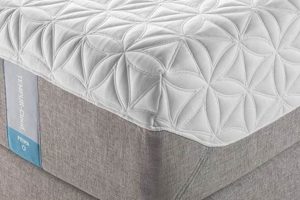The dimensions of a California King bed are standardized to provide a longer and narrower sleeping surface compared to a standard King. Specifically, this bed is designed to be 72 inches wide and 84 inches long. These figures are critical for ensuring proper fit within bedroom spaces and compatibility with bedding accessories.
Understanding these spatial requirements is essential for several reasons. It allows consumers to plan bedroom layouts effectively, preventing overcrowding and ensuring adequate walking space. Furthermore, accurate knowledge facilitates the selection of appropriate sheets, comforters, and bed frames, avoiding ill-fitting or inadequate coverage. Historically, this size originated to accommodate taller individuals who found standard King mattresses insufficient in length.
The subsequent discussion will delve into the practical considerations for choosing this bed size, the implications for room size and design, and a comparison with other mattress sizes available on the market, ultimately guiding informed decisions regarding bedroom furniture investments.
Guidance on Spatial Planning
This section offers essential advice concerning the spatial integration of a California King-size bed into various bedroom environments.
Tip 1: Measure the Room. Accurate assessment of the room’s dimensions is paramount before acquisition. Ensure sufficient space for the bed itself, along with walkways of at least 24 inches on each side for comfortable navigation.
Tip 2: Consider Other Furniture. Account for the placement of additional furniture pieces such as dressers, nightstands, and chairs. Prioritize ergonomic accessibility and avoid obstructing doorways or windows.
Tip 3: Factor in Door Swing. Evaluate the trajectory of door swings to prevent interference with the bed or other furniture. Repositioning the bed or reversing the door’s direction may be necessary.
Tip 4: Optimize Layout for Functionality. Organize the room to maximize functionality. Position the bed to capitalize on natural light and ventilation, while ensuring convenient access to electrical outlets.
Tip 5: Visualize with Tape. Before purchase, use masking tape to outline the bed’s dimensions on the floor. This provides a visual representation of the space it will occupy and facilitates adjustments to the layout.
Tip 6: Account for Bedding. Consider the additional space required for bedding, such as comforters and pillows, which can extend beyond the bed’s actual dimensions.
Adherence to these guidelines will ensure seamless integration of the bed into the designated space and optimize bedroom functionality.
The subsequent section will provide a comparative analysis of different mattress sizes to assist in selecting the most suitable option based on individual needs and spatial constraints.
1. Width
The “Width: 72 inches” specification is a definitive component of the overall dimensions that characterize a California King bed. This measurement dictates the lateral sleeping surface available and differentiates this mattress size from others, notably the standard King, which is wider. Its effect is primarily on the accommodation of multiple sleepers or individuals who prefer greater lateral space during sleep. A width of 72 inches can be insufficient for couples who desire substantial personal space but advantageous in bedrooms where length is more readily available than width.
The importance of this figure is underscored when selecting bedding, particularly fitted sheets. Sheets designed for a standard King bed, which typically have a larger width, will not fit properly on a California King, leading to ill-fitting and potentially disruptive bedding. Bed frame compatibility is also dependent on adherence to this specification; a frame intended for a wider mattress will leave gaps and compromise structural support. For instance, an individual moving from a Queen bed (60 inches wide) to a California King experiences a 20% increase in width, an important consideration for couples or single sleepers who value more space.
In conclusion, the 72-inch width is not merely an arbitrary figure; it is a defining attribute of a California King and a critical element for ensuring both comfort and compatibility with bedding and bed frames. Disregarding this specification leads to practical difficulties and compromises the intended benefits of this unique mattress dimension.
2. Length
The “Length: 84 inches” dimension is a crucial element when considering the overall dimensions of a California King bed. This measurement dictates the longitudinal sleeping surface, differentiating it from a standard King and influencing suitability for taller individuals. Its significance stems from its impact on comfort, spinal alignment, and overall sleep quality.
- Accommodation of Taller Individuals
The extended length primarily addresses the needs of individuals exceeding average height, typically those over six feet tall. This length ensures that the sleeper’s feet do not hang off the end of the bed, promoting better spinal alignment and reducing pressure points. For example, a person who is 6’4″ (76 inches) would have approximately 8 inches of clearance at the foot of the bed, a substantial improvement over standard mattress lengths.
- Room Space Optimization
While providing additional length, this dimension often results in a narrower width compared to a standard King bed. This trade-off is advantageous in bedrooms where length is more readily available than width. This characteristic can allow for more versatile furniture placement and improved room flow. For instance, in a long, narrow bedroom, a California King can fit more comfortably than a standard King, preserving walking space and accessibility.
- Bedding Compatibility Implications
The 84-inch length necessitates specific bedding tailored to this size. Standard-length sheets will be insufficient, leading to exposed mattress corners and a compromised aesthetic. Investing in sheets designed for a California King ensures a proper fit, preventing slippage and enhancing overall comfort. Using incorrectly sized sheets can diminish the intended benefits and shorten the lifespan of both the mattress and the bedding.
- Support for Specific Sleep Positions
The increased length supports various sleep positions, particularly those that involve stretching or extended leg movements. Individuals who prefer to sleep on their back with their legs extended, or those who tend to move frequently during sleep, benefit from this added length. The extra space reduces the likelihood of waking due to hitting the end of the bed, thereby promoting more restful sleep.
The consideration of the 84-inch length is paramount in the decision-making process when
selecting a California King mattress. This dimension not only caters to the specific needs of taller individuals but also impacts room layout and bedding choices. Properly understanding its role ensures optimal comfort and functional integration within the bedroom environment.
3. Area
The surface area, quantified as 4,896 square inches, represents a fundamental characteristic derived from the length and width dimensions that define a California King mattress. This figure provides a standardized metric for comparing sleeping surfaces and understanding the practical implications of choosing this specific bed size.
- Sleeping Space Quantification
This metric allows for a precise understanding of the available sleeping surface, enabling direct comparison with other mattress sizes. For instance, a Queen mattress, with an area of 4,800 sq. in., provides slightly less space than a California King. This quantification is crucial for consumers evaluating whether the mattress meets their individual or shared space requirements. The 4,896 sq. in. facilitates objective assessment beyond mere linear dimensions.
- Implications for Sleep Comfort and Movement
The surface area significantly impacts sleep comfort and freedom of movement during sleep. A larger area generally accommodates more movement and reduces the likelihood of disturbing a sleep partner. Individuals who toss and turn or prefer to stretch out benefit from the expansive surface. Specifically, the 4,896 sq. in. allows for a greater range of positions and minimizes edge crowding, enhancing sleep quality for active sleepers.
- Influence on Bedding Selection and Costs
The designated area directly influences the selection and cost of bedding. Sheets, comforters, and mattress protectors must be appropriately sized to adequately cover the surface. The area demands larger, and often more expensive, bedding items compared to smaller mattress sizes. Consumers must factor in these costs when evaluating the overall investment in a California King, recognizing that bedding needs are directly proportional to the mattress area.
- Room Size Considerations and Spatial Planning
The computed area dictates the spatial requirements within a bedroom. A larger area necessitates careful consideration of room dimensions and furniture placement. Consumers must ensure that the mattress area allows for comfortable movement and does not overcrowd the room. Effective spatial planning, informed by the 4,896 sq. in. value, ensures functional integration and prevents compromised room aesthetics.
In summary, the 4,896 sq. in. surface area is not merely a mathematical abstraction but a practical descriptor that influences comfort, bedding selection, and spatial arrangement. Understanding this metric facilitates informed decisions and ensures optimal satisfaction with the choice of a California King mattress. Comparison of the area with other sizes offers a tangible means of evaluating individual needs and preferences in sleeping arrangements.
4. Frame compatibility
The successful utilization of a California King mattress hinges significantly on frame compatibility, inextricably linking the dimensional specifications of the mattress to its supporting structure. The mattress, standardized at 72 inches wide and 84 inches long, necessitates a bed frame engineered to precisely accommodate these measurements. Mismatched dimensions result in compromised support, reduced comfort, and potential damage to both the mattress and the frame. For instance, a frame too large allows the mattress to shift, creating uneven weight distribution and premature wear. Conversely, a frame too small forces compression, altering the mattress’s intended shape and potentially damaging internal components. Therefore, frame compatibility is not merely an ancillary consideration but a critical determinant of the mattress’s performance and longevity. This understanding ensures that the intended benefits of a California Kingextended length and tailored supportare realized.
Beyond dimensional accuracy, construction materials and support systems within the frame are crucial. A frame constructed from inadequate materials may lack the structural integrity required to support the weight of the mattress and its occupants, leading to sagging or collapse. Furthermore, the spacing and design of support slats or platforms influence the mattress’s airflow and weight distribution. Insufficient support can lead to localized compression and increased wear. As an example, consider a platform bed with widely spaced slats; this configuration may allow the mattress to dip between the slats, resulting in uneven support and potential back discomfort. Therefore, frame compatibility extends beyond simple dimensional matching to encompass material strength, support structure design, and ventilation considerations.
In conclusion, achieving optimal sleep comfort and maximizing the lifespan of a California King mattress necessitates a comprehensive understanding of frame compatibility. Adhering to precise dimensional specifications, selecting durable construction materials, and ensuring adequate support mechanisms are essential steps. Failure to prioritize these factors compromises the benefits of this particular mattress size, leading to discomfort, premature wear, and ultimately, diminished value. Prioritizing frame compatibility is thus a critical element in the overall investment and satisfaction with a California King bed.
5. Bedding sizes
Bedding sizes are directly dictated by the dimensions of the mattress they are intended to cover. For a California King mattress, these dimensions necessitate specialized bedding to ensure a proper fit and optimal comfort. Understanding this relationship is crucial for consumers seeking to purchase compatible linens.
- Fitted Sheet Dimensions
Fitted sheets for a California King are designed to precisely match the 72-inch width and 84-inch length. Standard King sheets, being wider, will not adequately fit, resulting in slippage and reduced comfort. Proper fitted sheet dimensions ensure a secure fit and prevent the sheet from detaching during sleep.
- Flat Sheet Coverage
Flat sheets must provide adequate overhang to allow for tucking under the mattress and draping over the sides. Insufficient coverage results in exposed mattress areas and a less aesthetically pleasing appearance. The dimensions should exceed the mattress size by a sufficient margin to provide ample material for tucking and draping.
- Duvet and Comforter Sizing
Duvets and comforters are selected not only for aesthetic appeal but also for their ability to provide adequate warmth and coverage. Undersized duvets leave portions of the bed uncovered, while oversized options may overwhelm the bed and drag on the floor. California King duvets and comforters are typically larger than those for a standard King to accommodate the mattress’s length.
- Pillowcase Proportions
While pillow sizes are generally standardized, pillowcase dimensions must be proportional to the overall scale of the bed. Standard pillow
cases may appear undersized on a California King, impacting the visual balance of the bedding ensemble. King-size pillowcases, with their larger proportions, are more suitable for maintaining aesthetic harmony.
In summary, the relationship between mattress dimensions and bedding sizes is fundamental for achieving both comfort and aesthetic appeal. Precise adherence to recommended bedding sizes ensures optimal fit and coverage, while failing to do so can compromise comfort, aesthetics, and the overall sleep experience. Consumers must prioritize selecting appropriately sized bedding to fully realize the benefits of a California King mattress.
6. Room dimensions
The spatial requirements inherent in a California King mattress, defined by its specific measurements, directly dictate the suitability of the bed for various room dimensions. A mismatch between mattress size and room size introduces practical challenges and compromises both functionality and aesthetics. Specifically, smaller rooms risk overcrowding, hindering movement and impeding access to other furniture. For example, a bedroom measuring only 10 feet by 12 feet may be overwhelmed by a California King, leaving minimal space for walkways and ancillary furniture such as dressers or nightstands. This situation results in a cramped environment, negatively impacting usability and comfort. Conversely, excessively large rooms may diminish the visual impact of the bed, creating a sense of imbalance if the remaining space is not thoughtfully utilized. Thus, an informed consideration of room dimensions is paramount when assessing the appropriateness of this mattress size.
Accurate measurement of the room, followed by a visual representation of the bed’s footprint, is essential for preempting potential spatial conflicts. Employing masking tape to outline the bed’s dimensions on the floor serves as a practical method for visualizing its impact on room layout. This allows for the identification of potential obstructions, such as doorways or windows, and facilitates informed decisions regarding furniture placement. Moreover, accounting for additional space needed for walkways, typically a minimum of two feet on each side of the bed, ensures comfortable navigation. For instance, if the bedroom door swings inward, the bed’s placement must avoid impeding its full range of motion, necessitating careful planning and potentially requiring relocation of other furniture pieces.
In summary, the correlation between mattress dimensions and room size is a critical factor in bedroom design. An appropriately sized room enhances both the functionality and aesthetic appeal of the sleeping space. Careful consideration of room dimensions, coupled with accurate measurement and visualization techniques, ensures harmonious integration of the California King mattress and maximizes the usability of the entire room. Failure to adequately address this relationship can result in spatial constraints, reduced comfort, and compromised overall satisfaction.
Frequently Asked Questions
This section addresses common inquiries regarding the dimensions of a California King mattress, providing clarity and essential information.
Question 1: What are the precise dimensions of a California King mattress?
The standard measures 72 inches in width and 84 inches in length.
Question 2: How does the area compare to a standard King mattress?
A standard King mattress possesses a larger width but shorter length, resulting in a slightly greater overall surface area compared to a California King.
Question 3: What room size is generally recommended for a California King mattress?
A minimum room size of 12 feet by 12 feet is typically recommended to comfortably accommodate the bed and allow for adequate movement space.
Question 4: Is specialized bedding required for a California King?
Yes, fitted sheets, flat sheets, and comforters specifically designed for a California King are necessary to ensure a proper fit.
Question 5: Does the length make it suitable for taller individuals?
The extended length, relative to other mattress sizes, makes it well-suited for individuals exceeding six feet in height.
Question 6: What should be considered regarding the frame?
A bed frame explicitly designed for it is essential to ensure proper support and prevent damage to the mattress.
Understanding these key points ensures informed decision-making when selecting a mattress and optimizing bedroom space.
The subsequent article section will elaborate on the selection of compatible bed frames for California King mattresses.
Conclusion
The preceding analysis has meticulously explored measurements for a California King mattress, underscoring their profound implications for comfort, space utilization, and overall sleep quality. Critical dimensions, including width, length, and surface area, necessitate careful consideration to ensure appropriate selection and optimal integration within a bedroom environment. Compatibility with bed frames and bedding sizes are of similar importance.
Diligent adherence to these dimensional considerations guarantees a harmonious blend of functionality and aesthetic appeal. Disregarding these parameters risks compromising comfort, impeding spatial flow, and diminishing the value of the investment. Therefore, prospective purchasers are strongly advised to carefully assess room dimensions and bedding requirements before acquiring this specialized mattress size to ensure a fulfilling and restful sleep experience.




![Best California King Adjustable Mattress [Guide] Organic & Natural Mattress Buyer’s Guide: Non-Toxic Sleep Solutions Best California King Adjustable Mattress [Guide] | Organic & Natural Mattress Buyer’s Guide: Non-Toxic Sleep Solutions](https://mattressworldpa.com/wp-content/uploads/2025/07/th-8133-300x200.jpg)


